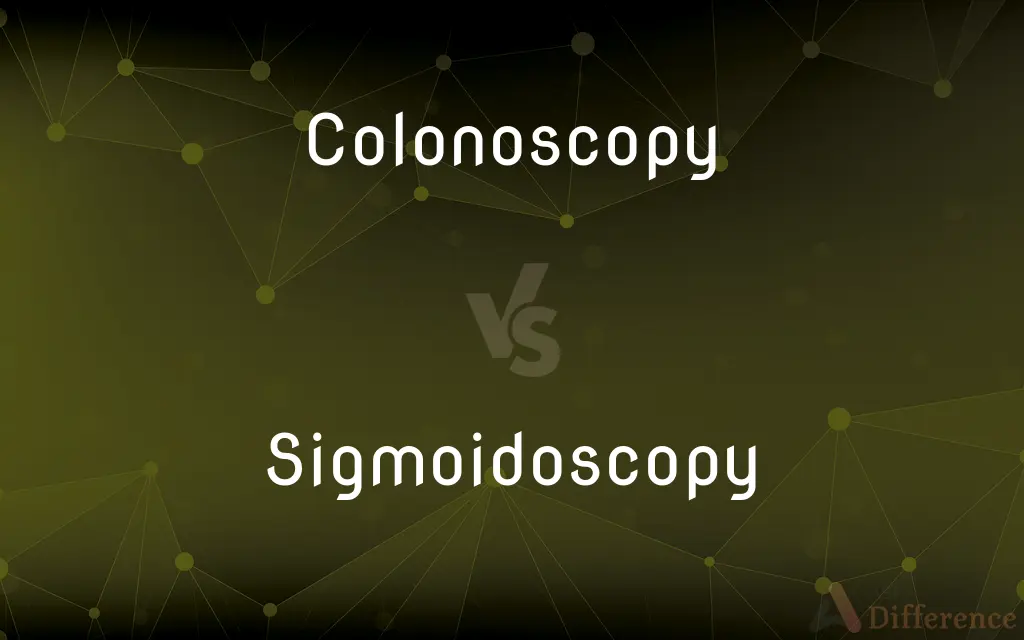Colonoscopy vs. Sigmoidoscopy — What's the Difference?
Edited by Tayyaba Rehman — By Urooj Arif — Updated on March 20, 2024
A colonoscopy examines the entire colon, detecting abnormalities or disease; sigmoidoscopy focuses on the sigmoid colon and rectum.

Difference Between Colonoscopy and Sigmoidoscopy
Table of Contents
ADVERTISEMENT
Key Differences
Colonoscopy is a medical procedure allowing doctors to examine the entire length of the colon for abnormalities or signs of colorectal cancer. Sigmoidoscopy, on the other hand, is similar to colonoscopy but is limited to examining the sigmoid colon and the rectal area.
While both procedures can be used for the detection and prevention of colorectal cancer, a colonoscopy provides a more comprehensive examination of the colon. This is crucial for early detection of colorectal cancer and other diseases, as the colonoscope can reach areas of the colon that the sigmoidoscope cannot. Additionally, during a colonoscopy, if polyps or abnormalities are found, they can often be removed or biopsied at the same time, which is not always possible with a sigmoidoscopy due to its limited scope.
In terms of preparation, patients undergoing a colonoscopy are required to follow a more stringent bowel cleansing process to ensure that the entire colon is clear of any waste material. This often involves consuming a special cleansing solution the day before the procedure. Sigmoidoscopy preparation is generally less intensive, with patients sometimes only needing to use enemas to clear the lower colon.
The choice between a colonoscopy and sigmoidoscopy can depend on various factors, including the patient's overall health, medical history, and the specific reasons for the examination. While a colonoscopy offers a more thorough examination of the colon, a sigmoidoscopy might be preferred in certain situations where a less invasive approach is suitable or when the focus is specifically on the lower part of the colon.
Comparison Chart
Scope
Examines the entire colon
Focuses on the sigmoid colon and rectum
ADVERTISEMENT
Procedure Length
Longer, often around 30-60 minutes
Shorter, usually about 15-20 minutes
Preparation
Requires extensive bowel cleansing
Often requires only enemas or less preparation
Sedation
Typically requires sedation
Usually does not require sedation
Polyp Removal
Allows for removal and biopsy of polyps anywhere in the colon
Limited to lower colon and rectal area
Compare with Definitions
Colonoscopy
Capability for intervention.
Polyps detected during a colonoscopy can often be removed immediately, reducing cancer risk.
Sigmoidoscopy
Focuses on the lower colon.
Sigmoidoscopy is specifically used to examine the sigmoid colon and rectum for abnormalities.
Colonoscopy
Requires extensive preparation.
Before a colonoscopy, patients must follow a clear liquid diet and consume a bowel-cleansing solution.
Sigmoidoscopy
Minimal preparation required.
Preparation for sigmoidoscopy might only involve a couple of enemas to clear the lower colon.
Colonoscopy
Involves sedation.
Patients usually receive sedation during a colonoscopy to ensure comfort throughout the procedure.
Sigmoidoscopy
Less invasive procedure.
Sigmoidoscopy generally does not require sedation and has a shorter recovery time.
Colonoscopy
A comprehensive examination.
A colonoscopy allows for a detailed inspection of the entire colon, aiding in early detection of colorectal cancer.
Sigmoidoscopy
Limited in scope.
While useful, sigmoidoscopies can miss polyps and cancers in the upper parts of the colon.
Colonoscopy
Colonoscopy () or coloscopy () is the endoscopic examination of the large bowel and the distal part of the small bowel with a CCD camera or a fiber optic camera on a flexible tube passed through the anus. It can provide a visual diagnosis (e.g., ulceration, polyps) and grants the opportunity for biopsy or removal of suspected colorectal cancer lesions.
Sigmoidoscopy
Screening and diagnostic tool.
Sigmoidoscopy can be a part of colorectal cancer screening, especially for individuals at lower risk.
Colonoscopy
Examination of the colon with a colonoscope. Also called coloscopy.
Sigmoidoscopy
Sigmoidoscopy (from the Greek term for letter "s/ς" + "eidos" + "scopy": namely, to look inside an "s"/"ς"-like object) is the minimally invasive medical examination of the large intestine from the rectum through the nearest part of the colon, the sigmoid colon. There are two types of sigmoidoscopy: flexible sigmoidoscopy, which uses a flexible endoscope, and rigid sigmoidoscopy, which uses a rigid device.
Colonoscopy
(medicine) The examination of the colon using a colonoscope.
Sigmoidoscopy
A tubular instrument used for inspection of the sigmoid colon.
Colonoscopy
Visual examination of the colon (with a colonoscope) from the cecum to the rectum; requires sedation
Sigmoidoscopy
(medicine) Internal examination of the sigmoid colon
Sigmoidoscopy
Visual examination (with a sigmoidoscope) of the lower third of the colon in a search for polyps
Common Curiosities
What is the main difference between a colonoscopy and a sigmoidoscopy?
A colonoscopy examines the entire colon, whereas a sigmoidoscopy only examines the sigmoid colon and rectum.
Can polyps be removed during both procedures?
Polyps can often be removed during a colonoscopy, but the ability to remove polyps during a sigmoidoscopy is limited to those found in the lower part of the colon.
What is the preparation like for a colonoscopy compared to a sigmoidoscopy?
Preparation for a colonoscopy is more extensive, involving a clear liquid diet and bowel-cleansing solutions, whereas sigmoidoscopy preparation may only require enemas.
Why would a doctor recommend a colonoscopy over a sigmoidoscopy?
A doctor may recommend a colonoscopy for a more comprehensive examination of the colon, especially if there's a higher risk of colorectal cancer or to investigate symptoms like unexplained gastrointestinal issues.
How often should one have a colonoscopy or sigmoidoscopy?
The frequency depends on individual risk factors, findings from previous screenings, and doctor recommendations. Colonoscopies are typically recommended every 10 years for those at average risk.
How long does each procedure take?
A colonoscopy typically takes 30-60 minutes, while a sigmoidoscopy is shorter, usually lasting about 15-20 minutes.
At what age should one start getting these procedures?
Current guidelines recommend starting regular colonoscopy screenings at age 45 for people at average risk of colorectal cancer, but this can vary based on individual risk factors.
Are there any risks associated with colonoscopies or sigmoidoscopies?
Both procedures are generally safe, but like all medical procedures, they carry some risks, including bleeding, perforation of the colon, and adverse reactions to sedation.
Is sedation required for both procedures?
Sedation is typically required for a colonoscopy to ensure comfort, while a sigmoidoscopy usually does not require sedation.
Can either procedure detect other diseases besides colorectal cancer?
Yes, both procedures can detect other forms of disease, such as inflammatory bowel disease, diverticulosis, and polyps.
Is there any pain associated with these procedures?
Discomfort can occur, but sedation during a colonoscopy usually prevents pain. Sigmoidoscopy might cause mild discomfort due to the insertion of the scope and air inflation.
Share Your Discovery

Previous Comparison
Search vs. Research
Next Comparison
Disorder vs. DisabilityAuthor Spotlight
Written by
Urooj ArifUrooj is a skilled content writer at Ask Difference, known for her exceptional ability to simplify complex topics into engaging and informative content. With a passion for research and a flair for clear, concise writing, she consistently delivers articles that resonate with our diverse audience.
Edited by
Tayyaba RehmanTayyaba Rehman is a distinguished writer, currently serving as a primary contributor to askdifference.com. As a researcher in semantics and etymology, Tayyaba's passion for the complexity of languages and their distinctions has found a perfect home on the platform. Tayyaba delves into the intricacies of language, distinguishing between commonly confused words and phrases, thereby providing clarity for readers worldwide.
















































